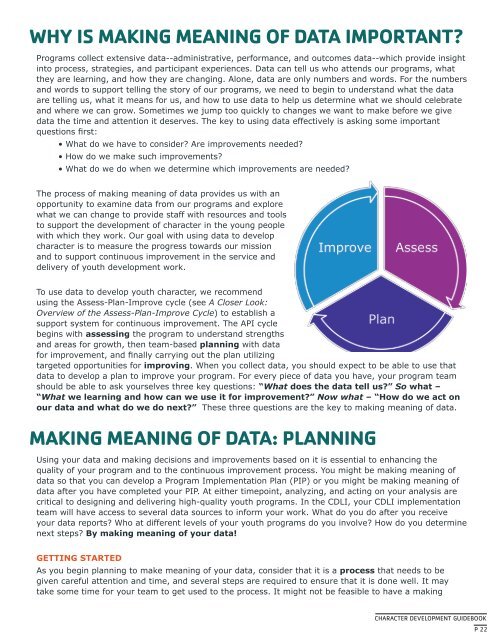CDLI_Guidebook_18_Final_Print
Create successful ePaper yourself
Turn your PDF publications into a flip-book with our unique Google optimized e-Paper software.
WHY IS MAKING MEANING OF DATA IMPORTANT?<br />
Programs collect extensive data--administrative, performance, and outcomes data--which provide insight<br />
into process, strategies, and participant experiences. Data can tell us who attends our programs, what<br />
they are learning, and how they are changing. Alone, data are only numbers and words. For the numbers<br />
and words to support telling the story of our programs, we need to begin to understand what the data<br />
are telling us, what it means for us, and how to use data to help us determine what we should celebrate<br />
and where we can grow. Sometimes we jump too quickly to changes we want to make before we give<br />
data the time and attention it deserves. The key to using data effectively is asking some important<br />
questions first:<br />
• What do we have to consider? Are improvements needed?<br />
• How do we make such improvements?<br />
• What do we do when we determine which improvements are needed?<br />
The process of making meaning of data provides us with an<br />
opportunity to examine data from our programs and explore<br />
what we can change to provide staff with resources and tools<br />
to support the development of character in the young people<br />
with which they work. Our goal with using data to develop<br />
character is to measure the progress towards our mission<br />
and to support continuous improvement in the service and<br />
delivery of youth development work.<br />
To use data to develop youth character, we recommend<br />
using the Assess-Plan-Improve cycle (see A Closer Look:<br />
Overview of the Assess-Plan-Improve Cycle) to establish a<br />
support system for continuous improvement. The API cycle<br />
begins with assessing the program to understand strengths<br />
and areas for growth, then team-based planning with data<br />
for improvement, and finally carrying out the plan utilizing<br />
targeted opportunities for improving. When you collect data, you should expect to be able to use that<br />
data to develop a plan to improve your program. For every piece of data you have, your program team<br />
should be able to ask yourselves three key questions: “What does the data tell us?” So what –<br />
“What we learning and how can we use it for improvement?” Now what – “How do we act on<br />
our data and what do we do next?” These three questions are the key to making meaning of data.<br />
MAKING MEANING OF DATA: PLANNING<br />
Using your data and making decisions and improvements based on it is essential to enhancing the<br />
quality of your program and to the continuous improvement process. You might be making meaning of<br />
data so that you can develop a Program Implementation Plan (PIP) or you might be making meaning of<br />
data after you have completed your PIP. At either timepoint, analyzing, and acting on your analysis are<br />
critical to designing and delivering high-quality youth programs. In the <strong>CDLI</strong>, your <strong>CDLI</strong> implementation<br />
team will have access to several data sources to inform your work. What do you do after you receive<br />
your data reports? Who at different levels of your youth programs do you involve? How do you determine<br />
next steps? By making meaning of your data!<br />
GETTING STARTED<br />
As you begin planning to make meaning of your data, consider that it is a process that needs to be<br />
given careful attention and time, and several steps are required to ensure that it is done well. It may<br />
take some time for your team to get used to the process. It might not be feasible to have a making<br />
CHARACTER DEVELOPMENT GUIDEBOOK<br />
P 22



